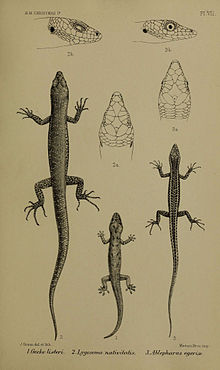Cryptoblepharus egeriae
| Christmas Island blue-tailed shining-skink | |
|---|---|

| |
| 1900 monograph of three Christmas Island reptiles, with the Christmas Island blue-tailed shinning-skink at right. | |
| Scientific classification | |
| Domain: | Eukaryota |
| Kingdom: | Animalia |
| Phylum: | Chordata |
| Class: | Reptilia |
| Order: | Squamata |
| Family: | Scincidae |
| Genus: | Cryptoblepharus |
| Species: | C. egeriae
|
| Binomial name | |
| Cryptoblepharus egeriae (Boulenger, 1888)
| |
| Synonyms[2] | |
Cryptoblepharus egeriae, also known
Etymology
The specific name, egeriae, is in honor of HMS Egeria.[7]
Description
The Christmas Island blue-tailed skink typically grows to a snout-to-vent length (SVL) of 4–5 cm (1.6–2.0 in).[5] It can be identified by its small black body with two yellow stripes running down the skink's back and onto its vibrant blue tail. The skink can use its blue tail to draw a predator's attention away from its body by separating its tail from its body. The bright color of the skink's tail means predators are much more likely to notice the tail than the skink's black body.[3]
Diet
The Christmas Island blue-tailed skink is a forager known as an insectivore.[5] Its diet primarily consists of crickets, beetles, flies, grasshoppers, spiders, and earthworms. It will occasionally eat some vegetation, though insects remain its primary source of food. Because of its small size, the Christmas Island blue-tailed skink forages for its food on the ground, over exposed rocks and low-lying vegetation, and will generally only eat prey that are slower moving.[7]
Reproduction
For the Christmas Island blue-tailed skink, the first
Distribution
Until the late 1990s, the Christmas Island blue-tailed skink was endemic to Christmas Island and could be found all over the island.[8] It currently exists in captive populations on Christmas Island, at Taronga Zoo, and on a small island (Pulu Blan) in the Cocos (Keeling) Islands where it has been released as part of an assisted colonization trial.[6]
Conservation efforts
The threat of extinction is largely attributed to introductions of invasive species, including a predatory wolf snake and the yellow crazy ant which were unintentionally brought to the island in the 1980s.[4] The Christmas Island blue-tailed skink is now extinct in the wild. However, Taronga Zoo currently has an active breeding program hosted by Taronga Conservation Society, which originated from 66 skinks that were brought into captivity before their population was wiped out.[6] The breeding program has been running for over a decade, with the goal of releasing some of the skinks back into their native habitat.[6] Since the Taronga Conservation Society conservation efforts began, 300 skinks have been introduced to the Cocos Islands.[6]
The genome of the blue-tailed skink (along with the Lister's gecko) was sequenced in 2022, marking the first high quality skink reference genome.[9] Analysis of this genome revealed high genetic diversity, reflective of large historical population sizes. However, regions of the genome also showed signs of recent inbreeding, likely because skinks used to found the captive population were somewhat related.[9]
Evolutionary relationships
C. egeriae is most closely related to the metallicus group of Cryptoblepharus, native to Australia, with the estimated divergence of C. egeriae from the group taking place around seven million years ago.[8] It has an XY sex determination system,[9] which is likely shared across all major skink lineages.
See also
References
- . Retrieved 18 November 2021.
- ^ Species Cryptoblepharus egeriae at The Reptile Database www.reptile-database.org.
- ^ ISSN 0370-2774. (Ablepharus egeriae, new species, pp. 535–536).
- ^ S2CID 234078176.
- ^ a b c "Options beyond captivity for two critically endangered Christmas Island reptiles". www.nespthreatenedspecies.edu.au. Retrieved 24 March 2022.
- ^ a b c d e "Saving the Blue-Tailed Skink". Saving the Blue-Tailed Skink | Taronga Conservation Society Australia. Retrieved 24 March 2022.
- ^ ISBN 978-1-4214-0135-5. (Cryptoblepharus egeriae, p. 81).
- ^ PMID 29899126.
- ^ S2CID 257363487.

